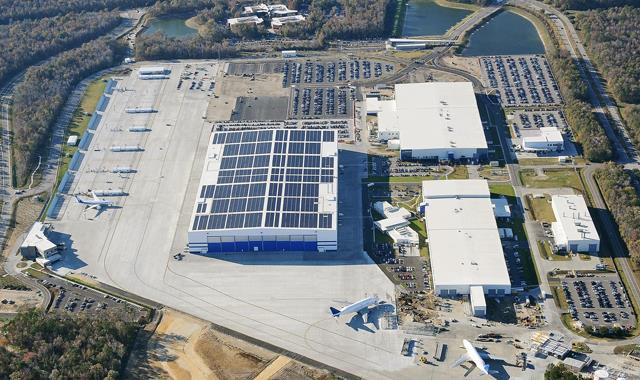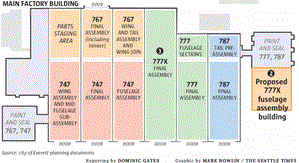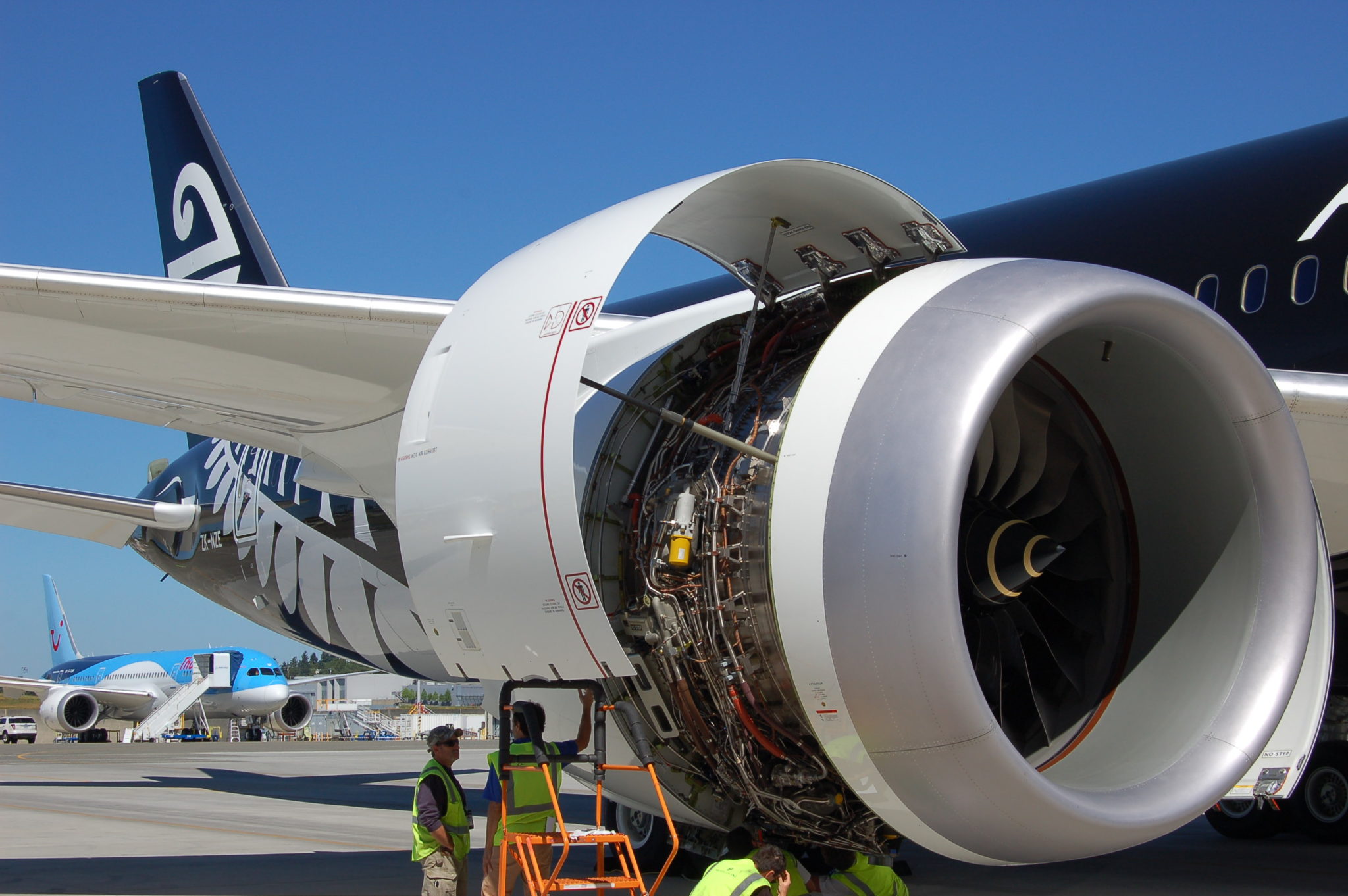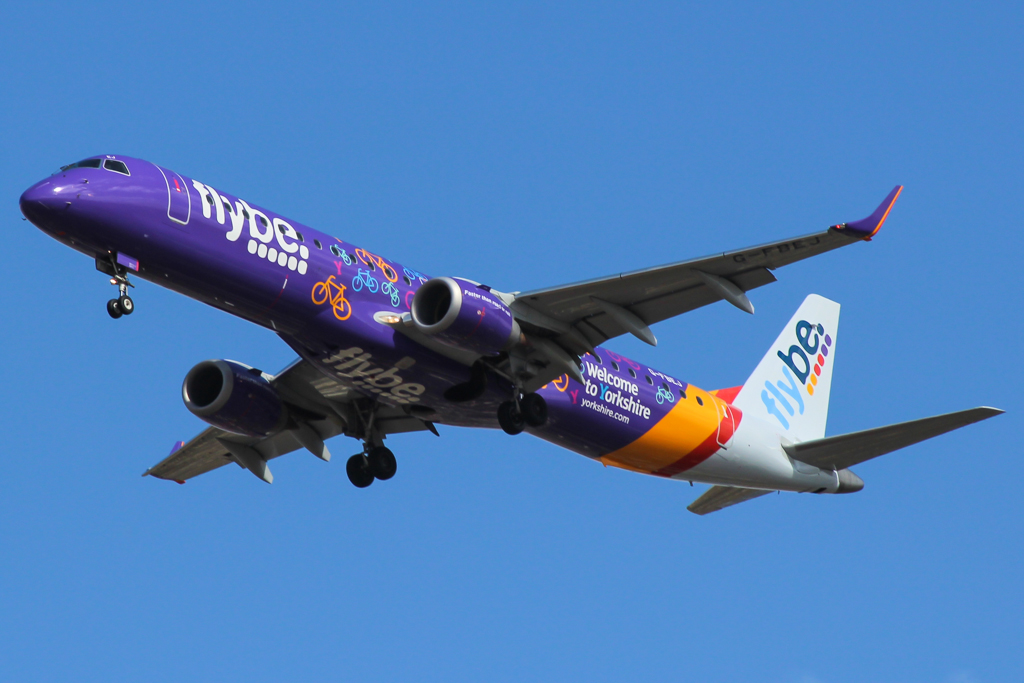Leeham News and Analysis
There's more to real news than a news release.
Nobody should be surprised at Boeing decision
| By Scott Hamilton
Commentary Oct. 1, 2020, © Leeham News: Nobody, but nobody, should be surprised that Boeing is going to consolidate 787 production in Charleston (SC). This die was cast Oct. 28, 2009, when Boeing announced that the second 787 Final Assembly Line would be placed in Charleston instead of Everett. It was only a matter of time.  Boeing 787 production and assembly plants in Charleston (SC). Source: Flight Global. |
With 787 FAL closing and 747 production ending, what does Boeing do with massive space in Everett?
Subscription Required
By Scott Hamilton and Bryan Corliss
Introduction
Oct. 1, 2020, © Leeham News: Boeing is expected to announce as early as today that it will consolidate the 787 final assembly lines into one at its Charleston (SC) plant.

Footprint of Boeing Everett final assembly building. This map is somewhat outdated but a current one is not available. Source: Seattle Times.
Reuters reported last week the decision to consolidate production in Charleston was made. The Wall Street Journal Tuesday night also reported this decision, saying the decision could be announced this week.
The Everett (WA) line is expected to close as production of the 787 falls below seven a month. Boeing previously announced the rate will fall from a peak of 14/mo to 6/mo by 2022.
With the closure of the 747 line in Everett slated for 2022, this will open huge bays in Everett. Nearly half the world’s largest building by volume will be empty. Given lower production rates because of the COVID-19 pandemic, the 777 lines will be woefully underutilized.
Overhead costs probably can’t be absorbed by the remaining low-rate production 767/KC-46A and 777 lines. Boeing warned in its 2Q2020 10Q SEC filing that the 787 and 777 lines face a forward loss depending on production rates of other lines.
With no New Midmarket Airplane (NMA) being contemplated to fill the empty bays, what can Boeing do to utilize these massive spaces and retain profitability of Everett?
A radical solution is moving the 737 line from Renton to Everett. This means Renton would close well before the 2033 date LNA predicts and selling off the property for commercial development.
Related stories
HOTR: Rolls 787 engine orders tank last 5 year
By the Leeham News team
Sept. 29, 2020, © Leeham News: Engine orders for Rolls-Royce on the Boeing 787 tanked in the last five years—pre-COVID.
An analysis reveals that over this period, Boeing booked 952 orders for 787. Of these, 755 selected the GEnx. A mere 80 orders were placed with RR. There were 117 orders for which engines were not selected. This gives GE a 90% share of the selected campaigns.
It gets worse.
Of the 80 aircraft that went to Trent 1000, Boeing removed 44 under ASC 606 accounting rules as too shaky to consider firm orders anymore. These include Avianca, Latam, Norwegian Air Shuttle, etc., which either went into bankruptcy or are restructuring as a result of COVID.
Under this scenario, GE’s share is closer to 95% in last five years.
RR’s Trent 1000 on the 787 is a thorn in the company’s side because of serious technical issues that grounded up to 50 aircraft. Groundings began several years ago. RR continues to deal with the financial fall-out. Some customers switched from RR engines to GEnx in follow-on orders for the 787.
The engine manufacturers worst hit by the pandemic
Subscription Required
By Bjorn Fehrm
Introduction
September 28, 2020, © Leeham News: The worldwide COVID-19 pandemic is shaking the air travel and airliner manufacturing industries like no crisis before.
More than 9/11, the oil crisis of 1973 or 2005 or the financial crisis of 2008. The problems for the airlines and the airframe OEMs are on the front pages of the world’s media.
The part of the airliner industry that is not so visible but is perhaps hardest hit, is the engine industry. Its weird business model amplifies the effects of the crisis.
Summary
- Airframe OEMs lose money on the first hundreds of aircraft produced.
- When they announce “black numbers”, it means the per aircraft losses stop. It doesn’t mean the aircraft program is positive.
- For engine OEMs, it’s worse. They never reach ‘black numbers” on engine production. Their only money makers are old engine programs that fly a lot.
A lost decade for aircraft manufacturers, suppliers
Subscription Required
Now open to all Readers
Introduction
By Judson Rollins, Bjorn Fehrm & Scott Hamilton
Sept. 21, 2020, © Leeham News: Commercial aviation is facing a lost decade due to COVID.
Yes, most forecasts target 2024-2025 as returning to 2019 passenger traffic and aircraft production levels.
However, LNA in July published its own analysis indicating full recovery may not occur until 2028. Breathless headlines notwithstanding, it will take years for vaccines to be widely available and considered safe by enough of the world’s population. Growing concern about vaccine production and distribution capacity through 2024 underscores this view. Even Southwest Airlines CEO Gary Kelly said earlier this month that business travel might not fully return for a decade.
Indeed, the 2020s may well be a lost decade for aircraft manufacturers and their supply chains.
 Summary
Summary
- Debt-laden airlines will have little money to order new airplanes
- Interest in re-engined 787, A350 likely nil this decade
- Airbus, Boeing, Embraer have little interest in launching new programs
- Engine makers too financially stretched to develop new designs
- Engineering talent, knowledge will be decimated by inevitable job reductions
- OEMs must “play the long game” at a short-term cost to safeguard their futures
Boeing seeks to cut production costs of 787-8 to boost sales
By Scott Hamilton
Sept. 2, 2020, © Leeham News: Boeing is considering production changes to the slow-selling 787-8 to lower costs and boost sales.
The effort comes at a time when global passenger traffic is at record lows and recovery of international traffic is forecast to take four or five years.
As airline traffic recovers, carriers appear to be favoring smaller aircraft in restarting suspended routes.
In recent years, Boeing discouraged sales of the 787-8 because it is a low margin airplane with high production costs. This is a legacy of the program and development difficulties from 2004-2011, when it finally entered service.
The 787-9 and 787-10 are high margin aircraft Boeing counted on to reduce the billions of dollars in deferred production and tooling costs. At one time, this exceeded $32bn.
The early program difficulties resulted in the production and parts of the -8 to be substantially different than the -9/10, which have 95% commonality. The -8 was only 30% common.
Pontifications: WA State frets about Boeing brain drain, but it’s already happening
Aug. 31, 2020, © Leeham News: Elected officials and others in Washington State worry about the “brain drain” as Boeing considers whether to consolidate 787 production from Everett to Charleston.
These people are asleep at the switch and have been for some time. The brain drain is already just around the corner.
Nearly half of the membership of SPEEA, the engineers and technicians union at Boeing, are 50 years or older right now.
Almost two thirds of these are within 55-64 years old. In other words, ready for retirement right now or soon to be.
R&D spending at Boeing plunges; Airbus yet to kick in
Subscription Required
By Scott Hamilton
Introduction
Aug. 24, 2020, © Leeham News: Research and development spending at Boeing Commercial Airplanes declined 21% in the first half this year compared with 2019.
From 2017 through 2019, BCA’s R&D spending declined 13%.
During the first half this year, Airbus Commercial airplanes R&D spending declined 1%. From 2017-2019, R&D spending increased 31%.
Boeing’s decline in 2019 vs 2018 and the first half of 2020 vs 2019 clearly reflects the grounding of the 737 MAX.
The flat spending in 2017-2018 reflects Boeing’s corporate approach of keeping R&D spending level while returning 100% of free cash flow to shareholders.
Airbus, on the other hand, was aggressively pursuing green aviation R&D, driven by a European Union that is more dedicated to green aviation than the USA is.
Summary
- COVID-19 related R&D spending cuts may not be fully seen until the third quarter.
- Boeing suspended R&D spending on the New Midmarket Airplane in January. Coupled with MAX grounding pressure, Boeing’s spending was already depressed.
- Airbus said it was suspending all R&D except for the A321XLR after the global COVID devastation on air passenger demand.
- Airbus historically outspends Boeing in R&D.
IAM warns members: Boeing is coming for concessions on 787 consolidation study
 Aug. 22, 2020, © Leeham News: The president of Boeing’s touch labor union, IAM 751, is warning members that the company study about potentially consolidating 787 production in Charleston could lead to a request for new concessions from the union.
Aug. 22, 2020, © Leeham News: The president of Boeing’s touch labor union, IAM 751, is warning members that the company study about potentially consolidating 787 production in Charleston could lead to a request for new concessions from the union.
IN a post yesterday on the union’s website, John Holden said a request from Boeing hasn’t happened yet—”however, it is something that we need to expect and prepare for, and we believe that we may be facing that threat soon.”






